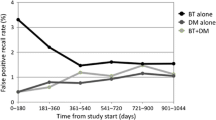Abstract
There is limited evidence on the role of 3D mammography with tomosynthesis in breast screening, although early studies suggest that it may improve specificity. We prospectively evaluated the effect of integrating 3D mammography as a triage to assessment in 158 consecutive recalls to assessment (recalled in standard 2D-mammographic screening) in asymptomatic subjects. Radiologists provided 3D mammography-based opinion as to whether recall/assessment was warranted or unnecessary, and all subjects proceeded to assessment. 3D triage was positive (confirmed the need for assessment) in all 21 subjects with breast cancer (there were no false negatives), and would have avoided recall in 102 of 137 (74.4%) subjects with a negative/benign final outcome in whom 3D triage did not recommend recall. Proportion of true negative 3D triage (as a proxy for potential reduction in recalls) was slightly higher in dense than non-dense breasts, did not differ across age-groups, but was significantly associated with the type of lesion seen on imaging (being highest for distortions, asymmetric densities, and lesions with ill-defined margins). While the simulation design may have over-estimated the potential for 3D mammography triage to reduce recalls, this study clearly demonstrates its capability to improve breast screening specificity and to reduce recall rates. Future studies of 3D mammography should further assess its role as a recall-reducing strategy in screening practice and should include formal cost-analysis.
Similar content being viewed by others
References
Glasziou P, Houssami N (2011) The evidence base for breast cancer screening. Prev Med [Epud ahead of print]. doi:10.1016/j.ypmed.2011.05.011
Kerlikowske K, Grady D, Rubin SM, Sandrock C, Ernster VL (1995) Efficacy of screening mammography. A meta-analysis. J Am Med Assoc 273:149–154
Laya MB, Larson EB, Taplin SH et al (1996) Effect of estrogen replacement therapy on the specificity and sensitivity of screening mammography. J Natl Cancer Inst 88:643–649
Lehman CD, White E, Peacock S et al (1999) Effect of age and breast density on screening mammograms with false positive findings. Am J Roentgenol 173:1651–1655
Brewer NT, Salz T, Lillie SE (2007) Systematic review: the long-term effects of false-positive mammograms. Ann Intern Med 146:502–510
Giordano L, Giorgi D, Piccini P, Ventura L, Stefanini V, Senore C, Paci E, Segnan N (2008) Time trends of process and impact indicators in Italian breast screening programmes-1996–2005. Epidemiol Prev 32:23–36
The National centre for Screening Monitoring: Eighth Report. http://win.osservatorionazionalescreening.it/eng-publications.php. Accessed 10 Oct 2011
Australian Institute of Health and Welfare (2009) BreastScreen Australia monitoring report 2005–2006. Cancer series no. 48. Cat. no. CAN 44. Canberra: AIHW. http://www.aihw.gov.au. Accessed 10 Oct 2011
Zappa M, Spagnolo G, Ciatto S, Giorgi D, Paci E, Rosselli Del Turco M (1995) Measurement of the costs in two mammographic screening programmes in the province of Florence, Italy. J Med Screen 2:191–194
Park JM, Franken EA Jr, Garg M et al (2007) Breast tomosynthesis: present considerations and future applications. Radiographics 27:S231–S240
Niklason LT, Christian BT, Niklason LE et al (1997) Digital breast tomosynthesis in breast imaging. Radiology 205:25–31
Rafferty EA, Georgian-Smith D, Kopans DB et al (2002) Comparison of full-field digital tomosynthesis with two view conventional film screen mammography in the prediction of lesion malignancy. Radiology 225:268
Teertstra HJ, Loo CE, van den Bosch MA et al (2010) Breast tomosynthesis in clinical practice: initial results. Eur Radiol 20:16–24
Mitka M (2008) New screening methods offer hope for more accurate breast cancer detection. J Am Med Assoc 299:397–398
Gur D (2007) Tomosynthesis: potential clinical role in breast imaging. Am J Roentgenol 189:614–615
Poplack SP, Tosteson TD, Kogel CA, Nagy HM (2007) Digital breast tomosynthesis: initial experience in 98 women with abnormal digital screening mammography. Am J Roentgenol 189:616–623
Gur D, Abrams GS, Chough DM et al (2009) Digital breast tomosynthesis: observer performance study. Am J Roentgenol 193:586–591
Pellegrini M, Bernardi D, Di Michele S et al (2011) Analysis of proportional incidence and review of interval cancer cases observed within the mammography screening programme in Trento province, Italy. Radiol Med 116(8):1217–1225
Andersson I, Ikeda D, Zackrisson S et al (2008) Breast tomosynthesis and digital mammography: a comparison of breast cancer visibility and BIRADS classification in a population of cancers with subtle mammographic findings. Eur Rad 18:2817–2825
Rafferty EA, Smith AP, Niklason, LT (2009) Assessing radiologist performance in dense versus fatty breasts using combined full-field digital mammography and breast tomosynthesis compared to full-field digital mammography alone. Radiologic Society of North America 95th Scientific Assembly and Annual Meeting; Chicago, IL
Moore RH, Boston MA, Kopans DB, et al (2007) Initial callback rates for conventional and digital breast tomosynthesis mammography comparison in the screening setting. Radiologic Society of North America 92nd Scientific Assembly and Annual Meeting; Chicago, IL
Caumo F, Brunelli S, Tosi E et al (2011) On the role of arbitration of discordant double readings of screening mammography: experience from two Italian programmes. Radiol Med 116:84–91
Aknowledgment
Dr Houssami is supported by the National Health and Medical Research Council program grant 633003 to the Screening and Test Evaluation Program.
Conflict of interest
The authors declare that they have no conflict of interest.
Ethical standards
The study design complies with the current Italian laws.
Author information
Authors and Affiliations
Corresponding author
Rights and permissions
About this article
Cite this article
Bernardi, D., Ciatto, S., Pellegrini, M. et al. Prospective study of breast tomosynthesis as a triage to assessment in screening. Breast Cancer Res Treat 133, 267–271 (2012). https://doi.org/10.1007/s10549-012-1959-y
Received:
Accepted:
Published:
Issue Date:
DOI: https://doi.org/10.1007/s10549-012-1959-y



